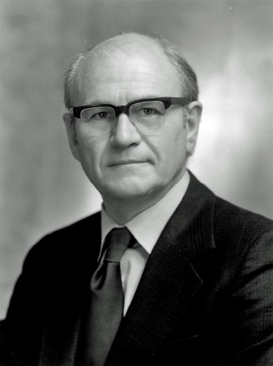Clifford Charles Butler facts for kids
Quick facts for kids
Sir
Clifford Charles Butler
FRS
|
|
|---|---|

Sir Clifford Charles Butler
© National Portrait Gallery, London |
|
| Born | 20 May 1922 Reading, Berkshire, England
|
| Died | 30 June 1999 (aged 77) Glenfield Hospital, England
|
| Alma mater | University of Reading |
| Spouse(s) | Kathleen Betty Collins |
| Children | Hilary and Ruth |
| Scientific career | |
| Fields | Particle physics |
| Institutions | University of Manchester Imperial College London |
| Doctoral advisors | Dr Tom Rymer |
Sir Clifford Charles Butler (FRS) was an English physicist. He was born on May 20, 1922, and passed away on June 30, 1999. He is best known for his important discovery of new types of tiny particles called hyperons and mesons. Later in his life, Sir Clifford became very involved in improving education. He worked as the director of the Nuffield Foundation and as the vice-chancellor of Loughborough University.
Contents
Sir Clifford's Early Life and Family
Clifford Butler was born in Reading, England. His father, Charles Hannington James Butler, worked as a clerk and buyer for a local food store. His mother was Olive Pembroke.
Clifford went to Reading School and then studied at the University of Reading. There, he earned both his first degree (Bachelor of Science) and his advanced research degree (Doctor of Philosophy).
In 1945, he started working as an assistant physics teacher at the University of Manchester. Two years later, in 1947, he became a full lecturer. That same year, he married Kathleen Betty Collins. They had two daughters together. Sir Clifford passed away in Glenfield Hospital, near Leicester, in 1999.
Discovering New Particles
At the University of Manchester, Clifford Butler worked with another scientist named G. D. Rochester. They were studying cosmic rays, which are high-energy particles that come from space. They used a special tool called a cloud chamber to see the paths of these tiny particles.
During their research, they saw two surprising events. One happened in October 1946, and the other in May 1947. These events showed particles that had never been seen before! They called these new particles "V particles" because of the V-shape their paths made in the cloud chamber. These V particles were much heavier than an electron and lasted a long time for nuclear particles.
To find even more of these particles, they moved their equipment to the Pic du Midi de Bigorre observatory. This observatory is high up in the Pyrenees mountains, where there are more cosmic rays. Other scientists, like a group from the California Institute of Technology led by Carl Anderson, also confirmed the existence of these particles.
Butler and his team continued to study them and found that there were actually two different types: hyperons and mesons. Their discovery was a very important first step in understanding what matter is made of, leading to the idea of quarks.
Leading Physics Research and Education
In 1953, Clifford Butler left Manchester and moved to London. He became the leader of a high-energy nuclear physics group at Imperial College London. He became a full professor in 1957 and the head of the physics department in 1963.
While at Imperial College, Butler led a group that designed the British National Hydrogen Bubble Chamber. This large device was used to study particles at places like the Rutherford Appleton Laboratory and CERN (a famous research organization in Europe). From 1964, he also led the CERN Track Chamber Committee.
In 1961, he was chosen to be a fellow of the Royal Society, which is a very important honor for scientists. He also served as the dean of the Royal College of Science from 1966 to 1969.
During this time, Sir Clifford became more and more interested in how education worked. He joined several important groups that helped plan and improve education in the UK. He was part of the academic planning board for the University of Kent in 1963, the Schools Council in 1965, and the University Grants Committee in 1966. He worked with the Schools Council for 19 years!
Focusing on Education
In 1970, Clifford Butler left Imperial College and stopped his active work in physics research. He took on a new role as the director of the Nuffield Foundation. This is a charity that helps improve education.
While at the Nuffield Foundation, he started new programs. These included a group for research in higher education, a program about law and society, and a center for agricultural strategy at the University of Reading.
He also played a big part in setting up the Open University. This university allows people to study for degrees from home. The Nuffield Foundation helped fund a genetics course there, which was used to test how other courses would work. Sir Clifford joined the council of the Open University in 1971 and stayed a member until 1995. He was also the vice-chairman from 1986 to 1995.
In 1975, Butler became the vice-chancellor of Loughborough University. He held this important position until he retired in 1985.
Honors and Awards
For all his important work in education, Clifford Butler was made a knight in 1983. This means he was given the title "Sir."

